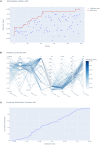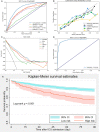A Machine Learning-Based Prediction Model for Acute Kidney Injury in Patients With Congestive Heart Failure
- PMID: 35310995
- PMCID: PMC8931220
- DOI: 10.3389/fcvm.2022.842873
A Machine Learning-Based Prediction Model for Acute Kidney Injury in Patients With Congestive Heart Failure
Abstract
Background: Machine learning (ML) has been used to build high performance prediction model. Patients with congestive heart failure (CHF) are vulnerable to acute kidney injury (AKI) which makes treatment difficult. We aimed to establish an ML-based prediction model for the early identification of AKI in patients with CHF.
Methods: Patients data were extracted from the Medical Information Mart for Intensive Care III (MIMIC-III) database, and patients with CHF were selected. Comparisons between several common ML classifiers were conducted to select the best prediction model. Recursive feature elimination (RFE) was used to select important prediction features. The model was improved using hyperparameters optimization (HPO). The final model was validated using an external validation set from the eICU Collaborative Research Database. The area under the receiver operating characteristic curve (AUROC), accuracy, calibration curve and decision curve analysis were used to evaluate prediction performance. Additionally, the final model was used to predict renal replacement therapy (RRT) requirement and to assess the short-term prognosis of patients with CHF. Finally, a software program was developed based on the selected features, which could intuitively report the probability of AKI.
Results: A total of 8,580 patients with CHF were included, among whom 2,364 were diagnosed with AKI. The LightGBM model showed the best prediction performance (AUROC = 0.803) among the 13 ML-based models. After RFE and HPO, the final model was established with 18 features including serum creatinine (SCr), blood urea nitrogen (BUN) and urine output (UO). The prediction performance of LightGBM was better than that of measuring SCr, UO or SCr combined with UO (AUROCs: 0.809, 0.703, 0.560 and 0.714, respectively). Additionally, the final model could accurately predict RRT requirement in patients with (AUROC = 0.954). Moreover, the participants were divided into high- and low-risk groups for AKI, and the 90-day mortality in the high-risk group was significantly higher than that in the low-risk group (log-rank p < 0.001). Finally, external validation using the eICU database comprising 9,749 patients with CHF revealed satisfactory prediction outcomes (AUROC = 0.816).
Conclusion: A prediction model for AKI in patients with CHF was established based on LightGBM, and the prediction performance of this model was better than that of other models. This model may help in predicting RRT requirement and in identifying the population with poor prognosis among patients with CHF.
Keywords: LightGBM; acute kidney injury; congestive heart failure; machine learning; prediction model.
Copyright © 2022 Peng, Li, Wang and Zhang.
Conflict of interest statement
The authors declare that the research was conducted in the absence of any commercial or financial relationships that could be construed as a potential conflict of interest.
Figures








Similar articles
-
Prediction of acute kidney injury in patients with femoral neck fracture utilizing machine learning.Front Surg. 2022 Jul 26;9:928750. doi: 10.3389/fsurg.2022.928750. eCollection 2022. Front Surg. 2022. PMID: 35959132 Free PMC article.
-
Prediction model of acute kidney injury after different types of acute aortic dissection based on machine learning.Front Cardiovasc Med. 2022 Sep 21;9:984772. doi: 10.3389/fcvm.2022.984772. eCollection 2022. Front Cardiovasc Med. 2022. PMID: 36211563 Free PMC article.
-
Interpretable machine learning for 28-day all-cause in-hospital mortality prediction in critically ill patients with heart failure combined with hypertension: A retrospective cohort study based on medical information mart for intensive care database-IV and eICU databases.Front Cardiovasc Med. 2022 Oct 12;9:994359. doi: 10.3389/fcvm.2022.994359. eCollection 2022. Front Cardiovasc Med. 2022. PMID: 36312291 Free PMC article.
-
Predicting renal function recovery and short-term reversibility among acute kidney injury patients in the ICU: comparison of machine learning methods and conventional regression.Ren Fail. 2022 Dec;44(1):1326-1337. doi: 10.1080/0886022X.2022.2107542. Ren Fail. 2022. PMID: 35930309 Free PMC article. Review.
-
Acute Kidney Injury Prognosis Prediction Using Machine Learning Methods: A Systematic Review.Kidney Med. 2024 Nov 15;7(1):100936. doi: 10.1016/j.xkme.2024.100936. eCollection 2025 Jan. Kidney Med. 2024. PMID: 39758155 Free PMC article. Review.
Cited by
-
Machine learning for prediction of acute kidney injury in patients diagnosed with sepsis in critical care.PLoS One. 2024 Apr 11;19(4):e0301014. doi: 10.1371/journal.pone.0301014. eCollection 2024. PLoS One. 2024. PMID: 38603693 Free PMC article.
-
Prediction of acute kidney injury in patients with liver cirrhosis using machine learning models: evidence from the MIMIC-III and MIMIC-IV.Int Urol Nephrol. 2024 Jan;56(1):237-247. doi: 10.1007/s11255-023-03646-6. Epub 2023 May 31. Int Urol Nephrol. 2024. PMID: 37256426
-
Enhancing Trauma Care: A Machine Learning Approach with XGBoost for Predicting Urgent Hemorrhage Interventions Using NTDB Data.Bioengineering (Basel). 2024 Jul 30;11(8):768. doi: 10.3390/bioengineering11080768. Bioengineering (Basel). 2024. PMID: 39199726 Free PMC article.
-
Effectiveness of Artificial Intelligence (AI) in Clinical Decision Support Systems and Care Delivery.J Med Syst. 2024 Aug 12;48(1):74. doi: 10.1007/s10916-024-02098-4. J Med Syst. 2024. PMID: 39133332 Review.
-
Machine Learning for the Prediction of Acute Kidney Injury in Critically Ill Patients With Coronary Heart Disease: Algorithm Development and Validation.JMIR Med Inform. 2025 May 28;13:e72349. doi: 10.2196/72349. JMIR Med Inform. 2025. PMID: 40383933 Free PMC article.
References
LinkOut - more resources
Full Text Sources

